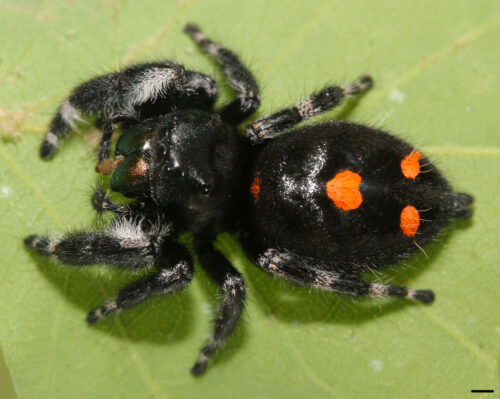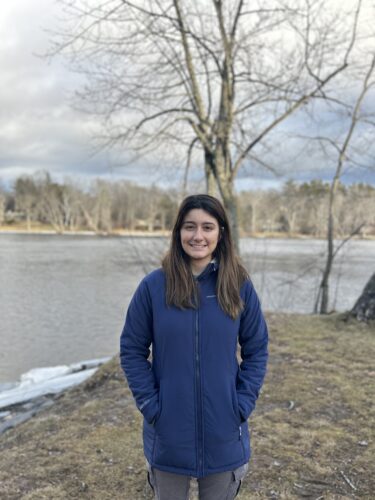
You’ve seen this spider, right? It lives in close proximity to humans and is one of the most common spiders in North America. You may have even Googled it to see if it’s poisonous, whether you knew the name or not. If you typed something like “spider with orange spots” into the search bar, you would find the Wikipedia article for the bold jumping spider. But before September 2022, the article was actually quite underdeveloped. That’s when a University of Maine student, Kaylee Hussey, began revamping it as part of Dr. Erin Grey’s class assignment.
Dr. Grey’s zoology course explores the evolution, diversity, morphology, life history, and ecology of invertebrates. As part of the course, students update a Wikipedia article related to an invertebrate species. They conduct a literature review and incorporate their research into an existing article format, providing Wikipedia’s thousands of daily visitors with scientific information from behind paywalls. Kaylee, who just completed her degree in wildlife ecology with a concentration in conservation biology, noticed many gaps in her choice of article. Important information about the bold jumping spider’s life cycle, diet, and taxonomy was missing.

“This was surprising to me, given how widespread and prevalent they are in human-occupied areas,” Kaylee says. “I was particularly surprised that the article provided only limited information on the spiders’ hunting behavior and vision, as these are key features of the Salticidae family.”
So, combing through more than 20 academic sources and reflecting on what information was most important to include, Kaylee went about correcting that. With our Authorship Highlighting tool, you can see that she’s now responsible for the majority of the article.
The Wikipedia assignment fits STEM-focused courses well, requiring students to summarize complex scientific content in their own words. For many, they are writing for the public for the first time and must rethink how to describe concepts for someone who is unfamiliar with their field of study.
“One of the most important skills I learned in the assignment was how to synthesize and distill complex scientific research into language that is accessible and understandable to a general audience,” says Kaylee.
Writing skills are essential for students who wish to enter STEM fields after their college years. They’ll be creating reports and grant applications, writing annotations on code, and publishing papers. Without an ability to communicate their ideas clearly, concisely, and accurately, they won’t be successful.
Wikipedia is not only a powerful tool for fostering these job skills in students, it also gives them a chance to communicate science to the public. The article about bold jumping spiders alone reaches about 400 daily visitors. The other articles that Dr. Grey’s students worked on have received almost 300K total views since the end of the course. These students have made a tangible difference for the public’s understanding of science.
Having the skills to communicate ideas clearly and effectively can also establish a young scientist with their colleagues. Students who pursue STEM careers must be prepared to speak in an accessible language where other scientists can follow their logic enough to collaborate and review their work. The Wikipedia assignment lets students practice describing complex concepts in plain language, with the added bonus of informing thousands of potential readers in the process.
“Research papers often contain specialized terminology and concepts that are intended for experts in the field. This makes it difficult for the general public to understand research and interpret it correctly,” Kaylee notes. “Additionally, many journals require you to pay in order to access these articles. This exclusivity makes it difficult for non-experts who want to learn about these topics to do so! Wikipedia is a great tool for communicating research to the public because it uses language and concepts that are understandable to non-experts and it is free. It also allows ideas from many sources to be combined and filtered to convey information that is reliable and significant. Writing this Wikipedia article really allowed me to improve my skills! I hope to write more articles in the future and make a difference.”
When the public has access to accurate, well-sourced scientific information, the possibilities are exciting. And Kaylee has a personal interest in making academic research more open.
“Ensuring that scientific research is inclusive and accessible is important for increasing public engagement and support for research,” Kaylee says. “It’s also important that information is available to everyone that is interested in learning about it! As a first generation student, I am passionate about making sure that science is not exclusive and is welcoming to everyone.”
Through the assignment, Kaylee was also able to renew her passion for her desired field and potentially inspire others.
“I hope to become a wildlife biologist and share my knowledge with a wide range of audiences to influence policy as well as encourage people to appreciate wildlife. I hope that readers will gain a deeper understanding of the complexity and uniqueness of spiders. They are often underestimated and feared, but I hope that readers will come to appreciate their unique way of existing and perceiving the world. It is interesting to try and imagine what it would be like to have eight eyes that have different capabilities. It makes you appreciate how they see the world differently than we do. Plus I hope readers will think they’re as cute as I do!”
Visit teach.wikiedu.org to find out more about how you can incorporate a Wikipedia project into your syllabus.
